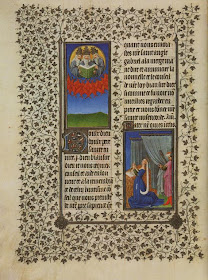These three cuttings are in some ways very similar to, but clearly not from the same parent manuscript as, a group of sixteen cuttings sold at Sotheby's, 8 February 1943, lot 106, the property of Miss E.A. Ranshaw, of London: eight were from the Hours of the Virgin; six from the Hours of the Passion; one, David in Penitence, was doubtless from the Seven Penitential Psalms; and the last, St Christopher, doubtless from a suffrage. We can therefore reconstruct the sequence as follows, with hypothetical lost miniatures in square brackets:
- Hours of the Virgin
- Matins.Annunciation
- [Lauds. Visitation?]
- Prime. Nativity
- Terce. Annunciation to the Shepherds
- Sext. Adoration of the Magi
- None. Presentation
- Vespers. Flight into Egypt
- Compline. Coronation of the Virgin
- Long or Short Hours of the Cross
- Betrayal and Arrest
- Christ before Pilate
- [Mocking?]
- Flagellation
- Carrying the Cross.
- [Crucifixion?]
- Deposition
- Entombment
- The Seven Penitential Psalms
- David in Penitence
- Suffrages
- [Trinity, et al.?]
- St Christopher
- [other male and female saints?]
The cuttings were published early the following year by Rosy Schilling, "An Unknown French Book of Hours (c.1400)", Burlington Magazine, 84 no.490 (January 1944), pp.20–24, with reproductions of six of them:
Four were acquired in 1943 by the Museum of Fine Arts, Boston (Inv.nos. 43.212–215):
Among the manuscript cuttings at the Los Angeles County Museum is one of the miniatures which has not been reproduced before, and whose current whereabouts were unknown to the MFA:
 |
| LACMA, 47-19-1 |
First, the column of text is extremely narrow, suggesting that the page was laid out in two columns, generally a very uncommon feature in Books of Hours, but found in a high proportion of those made for the Duke de Berry and his circle in the early 15th century. By way of example, here is a Yates Thompson manuscript that I have suggested elsewhere was owned by the Duke de Berry:
 |
| Princeton Museum of Art, y1992-163 |
and in the Très riches heures itself:
Second, the text on the back of the Los Angeles miniature is mainly in French verse:
"Qui le filz dieu porterent. / Le tres doulz fruit de vie.This raises the outside possibility that the manuscript was bilingual, with parallel columns of Latin and French, as in the Psalter of the Duke de Berry (with illumination by Jacquemart de Hesdin):
Et les doulces mamelles / Que le saulveur du mo(n)de.
Alaitta par amour. Ou / toute grace habonde. Am(en).
Pater n(oste)r. ut s(upra). / Ave maria."
Or perhaps the text was almost entirely in French, as in BL Harley MS 2952:
But perhaps more likely is that the main text of the Hours was in Latin, and each hour was followed by a prayer or prayers in French verse.
I was not able to see the Boston cuttings on my recent visit, but thanks to Ben Weiss I do have photographs of their backs. Three are pasted to card or parchment so that no text is visible, but the text on the fourth is mostly visible and legible. As with the Los Angeles cutting, the text has thus far defied identification, and may be unique. The cuttings may therefore be the only surviving witnesses to a very interesting lost manuscript from one of the greatest periods of French illumination.















No comments:
Post a Comment
** PLEASE INCLUDE YOUR NAME IN YOUR COMMENT **
I may ignore and delete anonymous comments